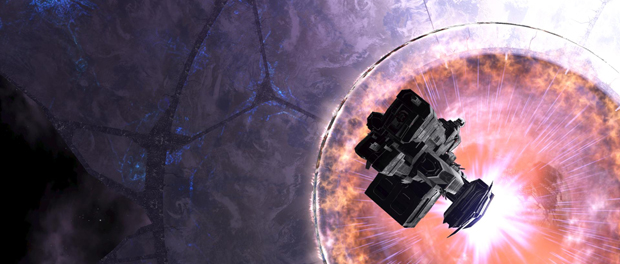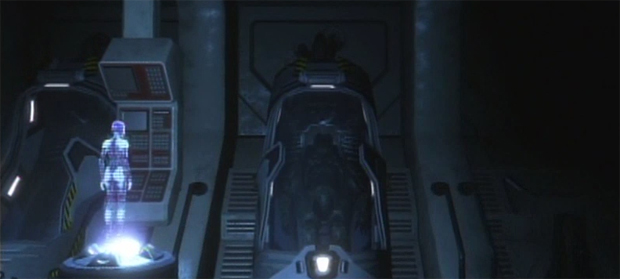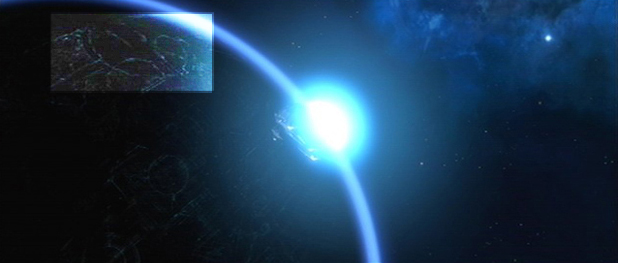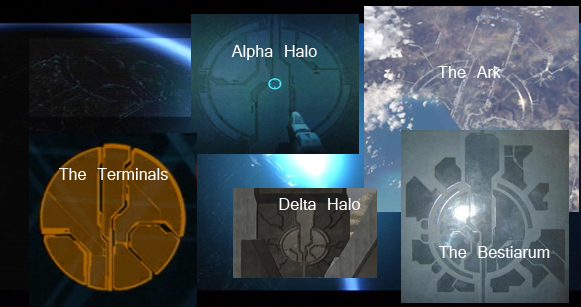Shield World

By now, we’ve all seen the questions emerge about who will produce the next Halo game, Bungie or a separate studio selected by Microsoft. Concern for the franchise’s precarious future was curbed with recent news of seasoned Bungie employees, writing manager Frank O’Connor specifically, moving to Microsoft in an effort to keep the IP’s canonical progress in check.
As incredibly significant as this might be, the more intriguing question that a lot of Halo fans have is: What will Halo 4 be like?
Obviously, the nomenclature “Halo 4” isn’t fully anticipated, but with rumors abounding, it seems like there are at least a few more fights to be finished – Halo 3 doesn’t appear to be the end of road for the series. By now, you may have heard the Marathon rumors which suggest that the next Halo game may attempt to integrate the fiction from both trilogies into an interesting reinvention. There’s also a rumor about a squad-based, third-person UNSC shooter prequel following the earlier stages of the Human-Covenant War. Some fans have even speculated on a separate story detailing the Elites’ return to Sanghelios.
But, nevertheless, most die hard followers of the Halo story see only one official first-party hint about what the next true Halo game will be…
The Legendary Ending of Halo 3.

Beyond the credits and the ending which shows the Master Chief and Cortana alive and well – we follow the severed hull of Forward Unto Dawn as it floats aimlessly in space. Cortana has activated a beacon for the UNSC to track, but it may be years before anyone even gets word that Spartan-117 is still alive.
As it moves slowly across the vacuum of darkness, the Dawn begins to approach what at first appears to be a planet. As the ship advances, however, the surface reveals a myriad of glowing shapes and geometric patterns when a star’s bloom crests over its curved horizon-line.
At this point, we only know this structure to be a “planetoid” – according to Joseph Staten.
GameTap: Is the Legendary ending of Halo 3 a nod to Marathon, or is it a reference to Ghosts of Onyx?
Joseph Staten: It’s more or less a nod to the beginning of Halo 1. Putting the chief back in his hushed casket, and shutting him down. Oh, wait, you mean the legendary ending of Halo 3 with the crazy planetoid thing? I don’t know! There is a crazy planetoid floating out there. Who knows? If you look really, really carefully at the lights on the planet, though, there is something to be seen in those lights.
What’s that? Something in the lights? If you’ve read our Terminal Visuals article, you’ll already know what he’s talking about:

While there may well be other significant symbols found on the surface of this planetoid structure (including one which resembles the Marathon symbol), the only one which is concretely obvious is found near the northern part of the planetoid.
If you don’t recognize it, you may have been living underneath a stone. The symbol has appeared in all three Halo games and in a slew of supplemental content as well:

What does it mean?
No one outside of Bungie really knows. It has been located on each Halo installation we’ve visited, the Ark and a variety of other places, so one might believe that it may not only deal with the Forerunners themselves, but specifically with the Halo Array.
One thoughtful observer has even suggested that it seems to depict a Halo ringworld and the Index, the key which can activate the Array from the installation’s control room. This idea was preceded with the notion that it might also be the “sword and shield” spoken of by Cortana in the Halo 3 Announcement Trailer and subsequently elaborated on in Eric Nylund’s Halo: Ghosts of Onyx.
Although both of these ideas sound plausible – the latter is what we will explore more thoroughly in a moment. One thing is absolutely certain: this place was built by the Forerunners and it was somehow connected to the rings.
When we consider the Halo Array’s corporeal embodiment, we think of the seven ringworlds and the cradle world which are linked together to form a weapon that holds both the destruction and the salvation for all intelligent life in the galaxy. Those who closely followed the story of Halo 3, or have been reading some of the fiction found just outside of the games, know that there is more to the Array than just those eight facilities.
“What does that mean?” Mendez asked, pointing to a double-lobed icon.
“This,” she whispered, “roughly translated, it means ‘shield world.'”
“Funny thing to call a place,” he observed.
In a moment of clarity she understood – not everything but enough to see a glimmer of the Forerunners’ plan.
For every coordinated military effort there were offensive and [defensive] aspects: attack, reinforcement, and, if needed, retreat. The Halo construct was only part of the Forerunner plan. Whatever was happening on this world was another portion of their strategy – triggered when Halo had been activated. [Halo: Ghosts of Onyx, pg. 181]
We originally discovered the term “shield world” in the aforementioned novel, Halo: Ghosts of Onyx. During the development of Halo 3, Nylund worked closely with Bungie to build a supplemental story in the wake of Halo 2 and prefacing Halo 3. This story involved a structure called Onyx. Originally thought to be a planet, the players involved in the story of Ghosts quickly learn that Onyx was much more than a planet – it was a Forerunner installation.
“There’s so much here,” Dr. Halsey whispered. “I’ve confirmed this world is part of the Forerunners’ plan together with the Halo rings – their ‘sword’ and ‘shield.’ Other parts still elude me. [Halo: Ghosts of Onyx, pg. 310]
During the events of Halo 2, Commander Miranda Keyes retrieved the Index just before Installation 05 was fired. This action halted the launching of the Halo Array, but it, in turn, generated a failsafe protocol. The Array was armed but could only be fired from the Ark.
According to Ghosts, this chain-reaction of events opened a rift which had since been dormant at the core of Onyx. It was later revealed that this mysterious planet was, in actuality, a shield world – a facility created by the Forerunners to protect against the phase pulse bombardment of the Array. When the failsafe protocol was enacted with the removal of the Index, a controlled slipspace rupture opened in Onyx’s ‘core room,’ but only for a very limited period of time.
“In sixty-eight minutes what was set in motion by the arming of Halo rings comes to completion on this world. The doorway to the core room of Onyx closes.” [Halo: Ghosts of Onyx, pg. 317]
Looking at the shield world from a broad perspective, one might ask what it meant to the Forerunners who built them? With the Conservation Measure in effect and room beyond the range of the Halo Array for other installations, why would a shield world need to be created in the first place?
According to the Terminals, the reason was time – or rather, a lack thereof.
Mendicant Bias, the AI initially charged with destruction of the Gravemind but eventually responsible for the Forerunners’ demise, had this to recommend before his demented fall to rampancy:
With my understanding of the enemy’s [modus operandi], its logical boundaries, and [catalog of witness] I have devised what I believe is our most sound fall-back strategy. By [cutting fire breaks[?]] into the [core worlds’ volume] we would be able to frustrate the enemy’s advances for approximately [70,080 hours] and lure them into costly naval battles. While its resources on the ground are effectively limitless, it has a finite number of vessels to spread from system to system. Fortunately the majority of them are unarmed and unarmored, private and commercial craft.
If we start immediately–commence total biosphere elimination of life sustaining worlds (as indicated in the accompanying charts) and relocate evacuated populations to facilities such as those described in the [Onyx project]–all this could be achieved in [57,1590 (+/-2,184) hours]. [Terminals, Halo 3 / T5-02-03]
During their darkest hour, Mendicant suggested destroying nearby stars – the solar center of strategically located systems – essentially creating a premature collapse of the celestial body and, in turn, the immolation of the entire system. This would form a firebreak and hedge the parasite in, buying the Forerunners more time. Before this could be done, however, he recommended that the populations of these systems be moved to specific facilities for their own safety – ones which could effectively shield these beings from the Halo effect.
Whether this was fully or partially achieved – or perhaps not even attempted at all – we do not know. We do know that when the protagonists of Ghosts accessed Onyx’s slipspace rupture through the core room, they were carried to something completely unique and different. Something no one had expected…
The slipspace rift had been stable when [they] had first passed through, dropping them three meters onto a grassy hill….
They could only watch as it compressed back to a single wavering dot and vanished.
Most of them had thought the slipspace passage would move them to an interior room within the artificial construct known as Onyx.
No one had been prepared for this. [Halo: Ghosts of Onyx, pg. 379]
Although technically remaining at the exact center of Onyx, the characters of the novel’s story were transported to a structure referred to as a Micro Dyson sphere – an artificial world not too unlike the Halo installations or the Ark. This particular megastructure, however, did not exist in real space and time like the other Forerunner constructs, but within the safety of a controlled rift in slipspace – and, without need for elaboration, its shape was also considerably different.
A very real man by the name of Freeman Dyson envisioned this hypothetical, sphere-like megastructure which could potentially be the residence of advanced extra-terrestrials who abandoned their original habitat. The term Micro Dyson sphere and its concept originates solely from him.
“We are inside a Micro Dyson sphere…
The Forerunners’ grasp of slipspace technology was far more advanced than ours or the Covenant’s… I believe this sphere resides in the center of the planet, encapsulated and protected by a slipspace bubble of compressed dimensionality.” [Halo: Ghosts of Onyx, pg. 381]
Although the structure itself had all of the external planetary trappings one might expect of a vast jungle world, the first indication of something peculiar was the ancient Forerunner city uncovered just below the surface. [Ghosts, pg. 269] When the protagonists discovered this city, it was abandoned; by the end of the novel, they had not located any surviving Forerunners or other species even within the protection of the sphere itself. [Ghosts, pg. 381]
The city had been buried under onyx stone during the 100,000 years of dormancy after the Forerunners fired the Array, only to begin to be excavated by human (and eventually Forerunner) machines just prior to the weapon network’s rearmament on Delta Halo. Interestingly noted, when Onyx’s surface began to come under attack, it started to splinter apart revealing that it was composed almost entirely of Forerunner AI constructs known as Sentinels. [Ghosts, pgs. 377-78] And much like the Halo installations, the key holders for the shield worlds would have to be the Forerunner’s surrogate heirs: the Reclaimers – humanity. [Ghosts, pg. 279]
The facility itself had several unique external attributes and elements existing in/on the world outside of the core room – the location of the slipspace rupture at the planetoid’s center:
- Translocation System, as witnessed in Halo: Combat Evolved and Halo 2, was a teleportation system which could carry individuals to different parts of the installation in an extremely short amount of time. [Ghosts, pg. 311]
- Map Room, also referred to as the Cartographer on other installations, essentially offered any visitors a full holographic repository of the structure’s areas of interest. [Ghosts, pgs. 275-76]
- Sentinel Factory, similar to the one seen during Halo 2 on Installation 05; Onyx’s facility, having to engineer Sentinels for all aspects of its planetary composition, was considerably more massive in size and capacity. [Ghosts, pgs. 315-16]
- Pod Chamber was a solitary room with pod-like structures lying low to the ground. The structures internally generated a controlled slipspace field allowing its contents to remain safe from the Array. [Ghosts, pgs. 334-37]
- Core Room Antechamber, a massive room near the center of Onyx where large pedal-like structures protruded when opening. These were nearly identical (but on a smaller scale) to Halo 3’s gateway portal of Voi, Kenya – only carrying slight differences in shape and size. Within the portal which these structures generated was the core room itself – access to the Micro Dyson sphere. [Ghosts, pgs. 354-55]
When the protagonists of Ghosts entered the blue-white bloom of light at the center of the antechamber – the core room – they were whisked away to the surface of the Micro Dyson sphere.
Overheard blazed a golden sun. The sky, if it could be called that, was robin’s-egg blue at the horizon but it quickly deepened to indigo and black the higher one looked, then warmed again as it neared the sun. There were no stars.
The surface stretched out in all directions – meadows, rivers, lakes, forests, winding paths all perfectly flat. All flat, that is, until [they] discovered that every horizon sloped upward until these curving surfaces vanished in the extreme distance. [Ghosts, pgs. 379-80]
Although referred to as a Micro Dyson sphere, the shape followed more closely to that of a Dyson shell – one of a variety of types seemingly envisioned by Freeman Dyson.
It was a hollow spherical structure twice the size of the distance between the Earth and our sun, 150 million kilometers in diameter from end to end. [Ghosts, pg. 380] Much like the concave shape of a typical Halo installation’s surface (but to a considerably greater degree), the facility depicted in Ghosts rose upward on all sides, creating a bowl-like environment, which, because of its size, was almost imperceivable. If one were to imagine it, they would see the interlining of the shell as being the surface of a planet, as opposed to the outer lining or crust which is where one would generally imagine the surface to be. The topology and geography was no different than one would find on a healthy world or any other Forerunner installation we’ve visited. The so-called “sun” was “consistent with a G2 type dwarf,” essentially at a slightly lower scale than Earth’s sun in Sol. It was an artificial star, acting like the sun, at the very center of the installation and approximately the same distance of the Earth to its own solar system’s center. [Ghosts, pg. 380]
Although clearly residing outside of space and time, the structure could only be accessed within the portal at the center of Onyx. With the slipspace rift closed, however, there was no known way to gain access to normal space and time. This would presumably be the topic of Nylund’s next Halo book, of which we can only expect to precede the launch of the next Halo title.
By now some may be asking how this loose supplemental canon is related to the Halo trilogy and the continuing of the Halo franchise. Why would Bungie place the player – the Master Chief even – in one of these shield worlds?
The only real evidence we have at our disposal is the Legendary Ending which clearly and distinctively shows the rear-section of Forward Unto Dawn floating helplessly toward the Forerunner megastructure. Could this be a completely new installation? Something entirely different than the shield worlds described in Onyx? Absolutely. Given our lack of any supporting evidence to the contrary, however, all signs currently point to the notion that during the final events of Halo 3, the Master Chief and Cortana did not fully make it through the portal that led from the Ark to Voi. Instead, their part of the Dawn was sent near another Forerunner structure – perhaps yet another failsafe measure which we’ve already become accustomed to within Forerunner protocol.
Earlier in Halo 3, 343 Guilty Spark even admits that he originally thought the Ark was a shield world – being that they provided similar purposes: safe havens from the Array. He was proven wrong in the cartographer as both he and the Master Chief discovered that the Ark simply exists outside the galaxy’s boundaries – not outside time and space like the core room of Onyx. Even the Halo 3 Bestiarum provides an interesting assessment, indicating that the “Shields” are active, functioning properly and operational – a peculiar entry if the plan involving them had no success at all:

If you take a look at the cover of Halo: Ghosts of Onyx, you’ll also see something interesting there. Even before this symbol became a point of interest within Halo 3’s documentation, it was plastered on the cover of Nylund’s book – a book focusing entirely on a shield world:

So what does all of this mean?
Could the next Halo game take place on a shield world? Will it involve the Master Chief and Cortana? Was the Legendary ending simply a lead-in to another character’s story or will the Master Chief, the Reclaimer, once again be sent to a Forerunner construct – this time to free its captives from a new menace rather than to destroy a galaxy-consuming parasite?
The idea sounds nostalgically satisfying, particularly the notion that the player would once again be returning to unknown territory – a new place to explore, to unlock secrets and to unveil ancient mysteries much like the experience of Halo: Combat Evolved. The concept also holds the promise of a small horror, the realization that in whatever direction this new game goes, the Master Chief and Cortana may well be alone in their plight. There are no Marines, no Sgt. Johnson; there are no Elites, no Arbiter – the Chief and Cortana are all that is left. This new entry into the core Halo franchise may be a truly interesting one – one part age-old mystery and another part isolated solitude.
Even if this brief and fanciful estimation is far off the mark, we await with bated breath at whatever may come. Only Bungie and those within Microsoft tasked with paving the future of the Halo franchise know the answer to these questions. Whatever Halo 4 brings upon its release, don’t fool yourself into thinking that you won’t be in line waiting for it when it does…
/vociferous